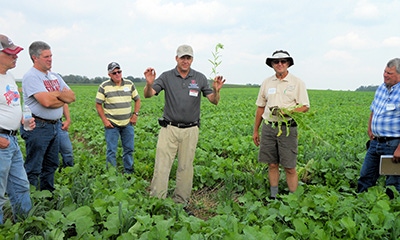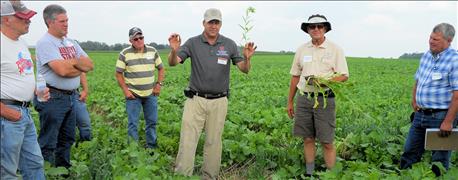
Last Monday, we shared Jim Biddle’s success of teaming up no-till with cover crops on 100% of Mill Hill Farm’s cropland near Williamsburg, Pa. And as Penn State Extension Agronomist Greg Roth noted: “He really saw soils respond to no-tilling once he started using cover crops.”
No-till’s advantages “weren’t too hard to buy into,” acknowledges Biddle, citing the reduced fuel needs, fewer field passes, and more. See No-tills not enough to build healthy soils .

KEEP THAT SOIL COVERED: That’s the central message that Jim Hoorman (center) preaches at meetings and field days.
“Cover crops, though, are a harder sell,” admits this producer who has been continuously cover-cropping since 2002. Then he adds: “Farmers tend to see them as an added expense – until they have a couple years’ experience.”
Related: No-till's not enough to build healthy soils
The truth: They are an expense item. But Biddle considers cover crops as an investment with earnings power. Jim Hoorman, Roth’s Extension counterpart at Ohio State University, wholeheartedly agrees – and has the numbers to back it up.
Legume cover crop costs range from $31 to $99 per acre, which includes $10 to $15 to plant and kill them, according to Hoorman. Grass and brassica cover crop costs range from $17 to $49 an acre. Cover crop seed prices are declining, and farmers are using lower seeding rates or cheaper seed, so the above noted costs may be on the higher side, he acknowledges.
While legumes tend to cost more, they also add 50 to 200 pounds of nitrogen per acre for the following crop. Most cover-croppers use a diverse seed mix to reduce costs, to increase soil diversity, and to improve soil resiliency
The 7-way pay-back
“Cover crops biggest benefit is its ability to ‘jump-start’ no-till’s environmental benefits,” contends Hoorman. Here’s how he quantifies those additive benefits:
* No-till savings: Factor in what you don’t spend on tillage trips across the field. That can range from $35 to $50 or more per acre. Use the money saved on tillage to invest in cover crop seed. Consider these costs, for instance, based on typical per-acre custom rates:
| Ohio (2010) | PA (2014) |
Chisel plow | $14 | $18 |
Tandem disk | $13 | $17.50 |
Field cultivator | $11 | $15.80 |
Moldboard plow | $17 | $20.30 |
Soil finishing | $11 | $15.80 |
Subsoiling | $18 | $24 |
* Top soil retention: There’s a substantial value of keeping the top three inches – the most productive – soil where it’s at. Hoorman pegs that value at $40 to $50 per acre based on saving 4 to 5 tons of topsoil per year valued $10 per ton.
~~~PAGE_BREAK_HERE~~~
Assuming 1% soil organic matter equals a yield increase of 12% in crop yields, building soil organic matter by 0.1 to 0.15 points per year boosts potential yield values by $6 to $15 an acre per year. This is very possible when teaming up no-till and cover crops, he contends.
Tillage, on the other hand, destroys SOM. No-till, by itself, may only maintain SOM levels.
Consider the numbers behind those numbers: Each 1% of SOM in the top 6 inches of soil weighs 10 tons per acre and is about 50% carbon. Based on market value for each 1,000 pounds of N and 100-plus pounds each of phosphorus, potassium and sulfur, these nutrients are valued at about $670 per acre for every 1% SOM.
* Building SOM levels: Generally, each 1% increase in SOM requires about 10 tons of decomposed crop plus cover crop residues. At normal decomposition rates, you can expect to accumulate about a 0.1 to 0.15% increase in SOM per year – equal to $67 to $100 acre.
That’s a minimum value which could easily double, he adds. SOM also has economic value for water storage, soil structure, microbial food and more. The more biomass that you produce with cover crop mixtures and preserve with no-till, the more your SOM levels will grow. But the practices must continue every year to do that, he points out.
* Reduced crop nutrient needs? Once a soil has a balanced pH, no-till plus cover crop soils may need less lime. Rising SOM is a natural buffer and increases soil cation exchange capacity.
“But I don’t want you to think you can cut soil nutrients by 50% to 70% the first year,” emphasizes the agronomist. “You have to build SOM first (double it), and do no-till and cover crops every single year over many years.”
That’s because building up 0.1% to 0.15% SOM per year requires an extra 100 to 150 pounds of N to stabilize it. That N must come from manure, growing legumes or fertilizer. That’s why no-till corn yields often struggle during the first few years.
Where farmers have doubled SOM levels over many years, the soil becomes ecologically balanced as microbial populations double or triple nutrient efficiency. Then, less fertilizer may be needed.
Soil microbes are just “soluble, living bags of fertilizer”, explains Hoorman. As many as 1,000 to 2,000 times more microbes are associated with a healthy root zone compared to a tilled rhizosphere.
“A key part of soil health is keeping those soil microbes healthy by growing live plants year-round, he stresses. “Nitrogen efficiency (uptake by plants) is only 30 to 40%; on phosphorus it ranges from 10% to 50%. By keeping actively growing soil microbes, nutrient efficiency of both increases.”
* Better drainage, less compaction: Cover crop roots help to dry out the soil and allow for earlier planting. Illinois data shows that ryegrass roots, even in clay soils, helps cumulatively increase corn yields. In a dry spring, the solution is to kill the cover crop early to keep the soil from getting too dry, adds Hoorman.
~~~PAGE_BREAK_HERE~~~
The cover crop/no-till combination helps soil become more porous and improves drainage. Increased soil structure improves its water-holding capacity, resulting in less runoff.
Cover crop roots promote drainage by forming channels for water to flow to subsurface (tile line) drains. That’s why Ohio no-till corn and soybean fields often have 3% to 10% yield gains when soil compaction is reduced.
* Reduced pesticide expenses: Farmers actually encourage weed seeds by tilling the soil, contends this Ohio State Extension educator. On the other hand, no-till plus cover crops may reduce herbicide costs about 33%. That’s $7 to $12 an acre, he adds.
Cover crops, like cereal rye and daikon radish, reduce weed germination. They simply out-compete weeds for sunlight, water, and nutrients.
“If you hate weeds so much, why are you preserving the seeds?” Hoorman asks with a wry smile.
Then there’s ”bug” control. Annual ryegrass, cereal (winter) rye and oilseed radishes may decrease soybean cyst nematodes by 80 to 90%.
Cover crops such as winter peas have proven to be an alternative food source for slugs, protecting corn from damage. “Slugs really don’t like to eat corn,” he says. “But if hungry enough, they’ll eat it.”
Providing a high-protein food source like winter peas or other legumes in the spring allows the corn to outgrow slug damage. Spring-growing cover crops also promote predators by providing shelter, food, and habitat for predators that feast on soft bodied insects, reducing their populations.
* Forage value: Don’t forget cover crops’ potential forage value for dairy and livestock. That’s why Biddle relies on triticale as a base cover crop.
Dairy and beef cattle farms have the opportunity to grow and utilize cover crops for forage. Some have very high feed value.
Next week, we’ll show you how 10-billion soil “bugs” makes soil healthier.
About the Author(s)
You May Also Like




